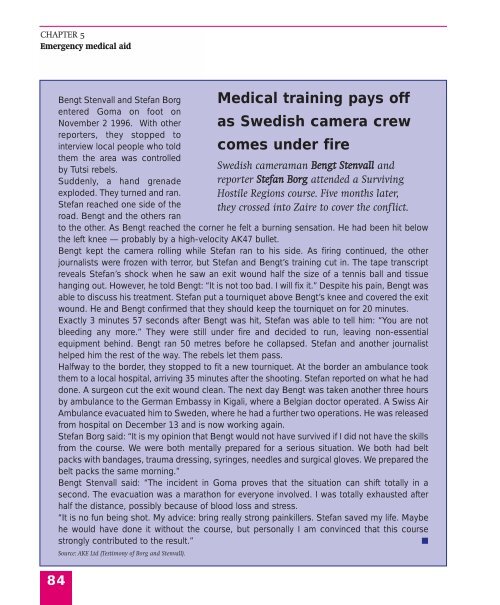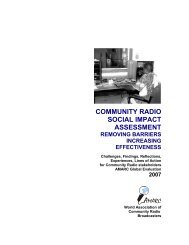Live News - A Survival Guide - International Federation of Journalists
Live News - A Survival Guide - International Federation of Journalists
Live News - A Survival Guide - International Federation of Journalists
- No tags were found...
Create successful ePaper yourself
Turn your PDF publications into a flip-book with our unique Google optimized e-Paper software.
CHAPTER 5Emergency medical aidBengt Stenvall and Stefan Borgentered Goma on foot onNovember 2 1996. With otherreporters, they stopped tointerview local people who toldthem the area was controlledby Tutsi rebels.Suddenly, a hand grenadeexploded. They turned and ran.Stefan reached one side <strong>of</strong> theroad. Bengt and the others ranto the other. As Bengt reached the corner he felt a burning sensation. He had been hit belowthe left knee — probably by a high-velocity AK47 bullet.Bengt kept the camera rolling while Stefan ran to his side. As firing continued, the otherjournalists were frozen with terror, but Stefan and Bengt’s training cut in. The tape transcriptreveals Stefan’s shock when he saw an exit wound half the size <strong>of</strong> a tennis ball and tissuehanging out. However, he told Bengt: “It is not too bad. I will fix it.” Despite his pain, Bengt wasable to discuss his treatment. Stefan put a tourniquet above Bengt’s knee and covered the exitwound. He and Bengt confirmed that they should keep the tourniquet on for 20 minutes.Exactly 3 minutes 57 seconds after Bengt was hit, Stefan was able to tell him: “You are notbleeding any more.” They were still under fire and decided to run, leaving non-essentialequipment behind. Bengt ran 50 metres before he collapsed. Stefan and another journalisthelped him the rest <strong>of</strong> the way. The rebels let them pass.Halfway to the border, they stopped to fit a new tourniquet. At the border an ambulance tookthem to a local hospital, arriving 35 minutes after the shooting. Stefan reported on what he haddone. A surgeon cut the exit wound clean. The next day Bengt was taken another three hoursby ambulance to the German Embassy in Kigali, where a Belgian doctor operated. A Swiss AirAmbulance evacuated him to Sweden, where he had a further two operations. He was releasedfrom hospital on December 13 and is now working again.Stefan Borg said: “It is my opinion that Bengt would not have survived if I did not have the skillsfrom the course. We were both mentally prepared for a serious situation. We both had beltpacks with bandages, trauma dressing, syringes, needles and surgical gloves. We prepared thebelt packs the same morning.”Bengt Stenvall said: “The incident in Goma proves that the situation can shift totally in asecond. The evacuation was a marathon for everyone involved. I was totally exhausted afterhalf the distance, possibly because <strong>of</strong> blood loss and stress.“It is no fun being shot. My advice: bring really strong painkillers. Stefan saved my life. Maybehe would have done it without the course, but personally I am convinced that this coursestrongly contributed to the result.”■84Source: AKE Ltd (Testimony <strong>of</strong> Borg and Stenvall).Medical training pays <strong>of</strong>fas Swedish camera crewcomes under fireSwedish cameraman Bengt Stenvall andreporter Stefan Borg attended a SurvivingHostile Regions course. Five months later,they crossed into Zaire to cover the conflict.
















